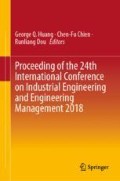Abstract
The traditional statistical process control (SPC) technique is used as a monitoring tool to recognize mean shifts of discrete manufacturing processes. The fundamental assumption using SPC is the independence of observed process data. Such assumption is usually violated in practical industries, which proceeds the development of alternative schemes to monitor auto-correlated processes. This paper approaches a long short-term memory (LSTM)-based model to recognize mean shifts of auto-correlated processes with different autocorrelation coefficients and shift parameters. The performance of the proposed method is evaluated by an average run length of time series residual control chart in comparison with other monitoring schemes. It was observed that the LSTM-based monitoring approach could improve significantly upon the early detection of out-of-control operating cases in auto-correlated processes.
Access this chapter
Tax calculation will be finalised at checkout
Purchases are for personal use only
References
C.W. Zobel, D.F. Cook, Q.J. Nottingham, An augmented neural network classification approach to detecting mean shifts in correlated manufacturing process parameters. Int. J. Prod. Res. 42(4), 741–758 (2004)
D. Montgomery, D.C. Friedman, Statistical Process Control in Computer Integrated Manufacturing (Dekker, New York, 1989)
D.F. Cook, C.-C. Chiu, Using radial basis function neural networks to recognize shifts in correlated manufacturing process parameters. IIE Trans. 30(3), 227–234 (1998)
D.F. Cook, C.W. Zobel, Q.J. Nottingham, Utilization of neural networks for the recognition of variance shifts in correlated manufacturing process parameters. Int. J. Prod. Res. 39(17), 3881–3887 (2001)
I. Sutskever, O. Vinyals, Q.V. Le, Sequence to sequence learning with neural networks. Adv. Neural Inf. Process. Syst. 3104–3112 (2014)
G.E. Dahl, D. Yu, L. Deng, A. Acero, Context-dependent pre-trained deep neural networks for large-vocabulary speech recognition. IEEE Trans. Audio Speech Lang. Process. 20(1), 30–42 (2012)
D. Ciresan, U. Meier, J. Schmidhuber, Multi-column deep neural networks for image classification, in CVPR (2012), pp. 3642–3649
H. Sak, A. Senior, F. Beaufays, Long short-term memory based recurrent neural network architectures for large vocabulary speech recognition, no. Cd (2014)
F.A. Gers, J. Schmidhuber, LSTM recurrent networks learn simple context free and context sensitive languages. IEEE Trans. Neural Netw. 12(6), 1333–1340 (2001)
H. Palangi et al., Deep sentence embedding using long short-term memory networks: analysis and application to information retrieval. IEEE/ACM Trans. Audio Speech Lang. Process. 24(4), 694–707 (2016)
H. Sepp, J. Schmidhuber, Long short-term memory. Neural Comput. (1997)
A. Graves, J. Schmidhuber, Framewise phoneme classification with bidirectional LSTM networks, in Proceedings of International Joint Conference on Neural Networks, vol. 4 (2005), pp. 2047–2052
T.P. Longnecker, M.T. Ryan, Charting correlated process data (1993)
J. Yu, J. Liu, LRProb control chart based on logistic regression for monitoring mean shifts of auto-correlated manufacturing processes. Int. J. Prod. Res. 49(8), 2301–2326 (2011)
D.G. Wardell, H. Moskowitz, R.D. Plante, Run-length distributions of special-cause control charts for correlated processes. Technometrics 36(1), 3–17 (1994)
H.B. Hwarng, Detecting process mean shift in the presence of autocorrelation: a neural-network based monitoring scheme. Int. J. Prod. Res. 42(3), 573–595 (2004)
Acknowledgements
This research was supported by the National Natural Science Foundation of China (No. 51375290, 71777173), the Fundamental Research Funds for Central Universities and Shanghai Science.
Author information
Authors and Affiliations
Corresponding author
Editor information
Editors and Affiliations
Rights and permissions
Copyright information
© 2019 Springer Nature Singapore Pte Ltd.
About this paper
Cite this paper
Chen, Sm., Yu, Jb. (2019). Mean Shifts Monitoring of Auto-correlated Manufacturing Processes Using Long Short-Term Memory-Based Recurrent Neural Network. In: Huang, G., Chien, CF., Dou, R. (eds) Proceeding of the 24th International Conference on Industrial Engineering and Engineering Management 2018. Springer, Singapore. https://doi.org/10.1007/978-981-13-3402-3_10
Download citation
DOI: https://doi.org/10.1007/978-981-13-3402-3_10
Published:
Publisher Name: Springer, Singapore
Print ISBN: 978-981-13-3401-6
Online ISBN: 978-981-13-3402-3
eBook Packages: Business and ManagementBusiness and Management (R0)

